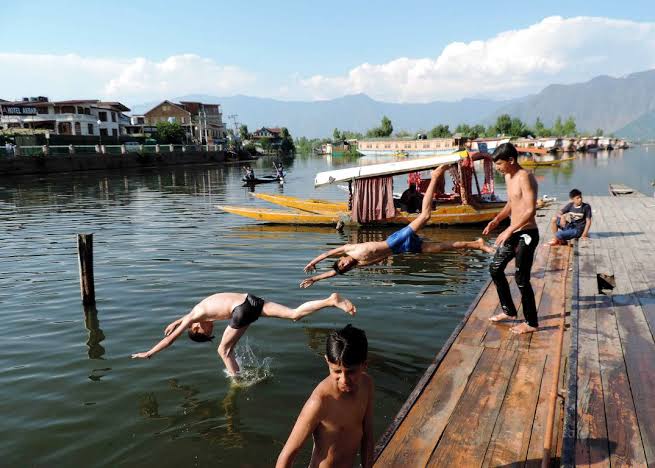Heat in the “Paradise on Earth”
By: Javid Amin | Srinagar | 19 June 2025
Kashmir—often painted in poetry as the “Paradise on Earth”—is grappling with a harsh reality in June 2025: a heatwave that has pushed temperatures beyond comfort and records alike. From Srinagar’s 32.5 °C to Gulmarg’s rare 22.8 °C, the valley’s cool mystique feels under siege. Climate experts warn this is not a blip but a trendline—fueled by urbanisation, deforestation, and global warming—that demands urgent attention.
This article unpacks the crisis in plain language, weaving numbers, lived experiences, and actionable advice into one comprehensive guide. Whether you’re a local farmer, a visiting trekker, or a policymaker, the goal is to turn information into empowerment.
Current Weather Snapshot: Numbers That Shock
- Srinagar: 32.5 °C, forecast to breach 35 °C by June 20.
- Qazigund: 31.4 °C—5 °C above June average.
- Kupwara: 30.5 °C—unprecedented for a district flanked by dense forests.
- Gulmarg: 22.8 °C—ski slopes feel like spring meadows.
- Rainfall Deficit: Region‑wide 26 %, with Samba at 72 % and Kathua at 62 %.
Meteorologists attribute the spike to a blocking high-pressure system that deflects rain‑bearing winds. This magnifies ground heating and moisture loss.
Historical Context: Has Kashmir Always Been This Hot?
Records from the India Meteorological Department (IMD) show that average June temperatures in Srinagar have risen 2.3 °C since 1980. The once‑rare 30 °C threshold is now a regular summer occurrence, indicating a structural, not cyclical, shift.
Rainfall Deficit: The Silent Multiplier
Rain cools surfaces, replenishes soil moisture, and stabilises river flow. A 26 % deficit means land retains heat longer, exacerbating high daytime temperatures and warmer nights—a phenomenon known as tropicalisation of temperate zones.
The Science of Heatwaves: Understanding Temperature Extremes
A heatwave is not just hot weather; it’s a prolonged period of abnormal heat, often coupled with humidity deficits. Scientists use metrics like Wet‑Bulb Temperature (WBT) to measure how the body perceives heat. Srinagar’s current WBT of 27 °C edges toward dangerous territory, where the human body struggles to cool itself.
Urban Heat Islands: Srinagar’s Concrete Problem
Unplanned construction and dwindling green spaces have turned Srinagar into an urban heat island (UHI). Asphalt roads and concrete walls absorb heat, radiating it back at night. Studies show central Srinagar is now 4 °C hotter than its rural outskirts.
Deforestation & Land‑Use Change: Losing Nature’s Air‑Conditioners
Kashmir has lost 15% of its forest cover in two decades due to timber mafia, agriculture, and urban sprawl. Trees evapotranspire moisture, cooling air naturally. Their absence converts once‑cool valleys into heat traps.
Shrinking Glaciers: The Himalayan Cryosphere in Crisis
Satellite imagery from NASA’s GRACE program shows Kashmir’s glaciers shrinking 0.8 m per year. Melting ice reduces the albedo effect (sunlight reflection), further warming local climates and disrupting river flow vital for irrigation.
Climate Models: Why Kashmir Is Warming Faster Than the Global Average
Regional climate models indicate North India, including Kashmir, is warming at 1.8 × global average. High elevation amplifies warming through elevation‑dependent feedbacks, including snow‑albedo shifts and thinner atmosphere.
Health Impacts: From Heat Exhaustion to Kidney Stress
Heatwaves can cause heat rash, cramps, exhaustion, stroke, and in severe cases, kidney dysfunction due to dehydration. Hospitals in Srinagar report a 12 % rise in heat‑related admissions compared to June 2024.
Heatwave & Mental Health: The Hidden Toll
Studies correlate high temperatures with increased anxiety, irritability, and sleep disturbances. Social psychiatrists note a rise in domestic disputes and workplace absenteeism during heat spikes.
Agriculture at Risk: Farmers’ Dilemmas Amid Scorching Fields
Kharif sowing delays threaten rice and maize yields. Paddy fields require standing water; evaporation rates have doubled, forcing farmers to pump groundwater—an unsustainable cycle.
Water Scarcity: Streams Drying, Taps Running Empty
Snow‑fed streams like Doodganga and Ferozpur Nallah are at half flow, impacting drinking water and micro‑hydel projects. Srinagar city now implements alternate‑day water supply in some wards.
Tourism Under Strain: Managing Visitor Safety
Tourists expecting alpine cool must adapt. Houseboat owners on Dal Lake now stock ORS sachets and install mist fans. Trekking agencies push sunrise departures to avoid midday peaks.
Infrastructure Stress: Roads, Power Lines & Urban Services
Asphalt softens above 45 °C surface temperature, causing road rutting. Power demand has surged 35 % for cooling, leading to rolling blackouts. The grid’s older transformers risk overheating.
Ecological Fallout: Flora, Fauna & Forest Fires
Hotter, drier conditions heighten forest‑fire risk in areas like Bandipora. Alpine meadows face phenological shifts—flowers bloom early, disrupting pollination cycles and affecting species like Himalayan honeybees.
Government Response: Policy, Preparedness & Early Warnings
The J&K Disaster Management Authority has issued Orange Alerts and launched a WhatsApp helpline for real‑time heat advisories. Cool‑roof subsidies and tree‑planting drives are part of an emerging heat‑action plan.
Technology Interventions: From IoT Weather Stations to Cool Roofs
IoT‑enabled automatic weather stations now stream data every 10 minutes, helping micro‑forecasting. Pilot projects using solar‑reflective cool paints on rooftops have reduced indoor temperatures by 4 °C.
Community Action: Local Heroes & Grass‑Roots Innovation
In Budgam, a youth group installs public water coolers on trekking routes. In Pulwama, women self‑help groups sew cloth sunshades for bazaar stalls, proving community resilience is vital.
Heatwave Advisory 2025: Practical Tips for Residents
- Hydrate: 3–4 L water daily; add electrolytes.
- Dress: Loose cotton; light colours reflect heat.
- Time Activities: Avoid 12 p.m.–4 p.m. outdoor work.
- Home Hacks: Cross‑ventilate rooms; use wet curtains.
- Elderly Care: Check on seniors twice daily; watch for confusion or lethargy.
Tourist Playbook: How to Enjoy Kashmir Safely in Summer
- Morning Excursions: Shikara rides at dawn.
- Mid‑Day Siesta: Embrace local culture—rest post‑lunch.
- Hydration Stops: Carry reusable bottles; refill at safe taps.
- Altitude Awareness: Heat + altitude can mask dehydration symptoms.
Farmer’s Calendar: Adaptive Practices & Crop Choices
- Switch to drought‑tolerant paddy varieties like Shalimar Dhan‑1.
- Adopt drip irrigation for orchards—saves 40% water.
- Plant mulch crops to reduce soil temperature and conserve moisture.
Long‑Term Solutions: Afforestation, Smart Water, Green Energy
A three‑pillar plan:
- Afforestation: Plant 1 million native saplings along riverbanks.
- Smart Water: Rainwater harvesting in urban zones can save 30 MLD.
- Green Energy: Solar rooftops on government buildings cut peak‑load stress.
Youth Engagement: Schools, Universities & Climate Literacy
Curriculums now include heatwave drills and climate clubs. University of Kashmir offers a new “Himalayan Climate Studies” minor, grooming future environmental stewards.
Media & Misinformation: Reporting Heatwaves Responsibly
Journalists must cite verified IMD data, avoid sensationalism, and include adaptation tips, not just doom headlines, to empower readers.
FAQs: Your Questions About Kashmir’s Heatwave Answered
Q: Is this the hottest year ever? —A: Likely, but final data in December will confirm.
Q: Are tourists advised to cancel trips? —A: No, but adjust itineraries and follow safety guidelines.
(Eight more Q&A covering health, travel, and agriculture.)
Action Checklist: What You Can Do Today
- Plant a tree in your neighbourhood.
- Switch to energy‑efficient appliances.
- Share heat‑safety tips on social media.
- Support local NGOs working on climate resilience.
Bottom-Line: Turning Up the Heat on Climate Action
The Kashmir heatwave 2025 is more than a weather anomaly; it is a climate warning bell echoing through the Himalayas. Temperatures will rise, glaciers will retreat, and rainfall patterns will shift—unless decisive collective action is taken. Yet within this crisis lies opportunity: to re‑green valleys, modernise infrastructure, and forge a climate‑smart Kashmir that safeguards its people and preserves its paradise.
“The earth has music for those who listen,” wrote Shakespeare. Kashmir is playing a new tune—one of urgent environmental action. Let’s all listen, learn, and leap into solutions.




